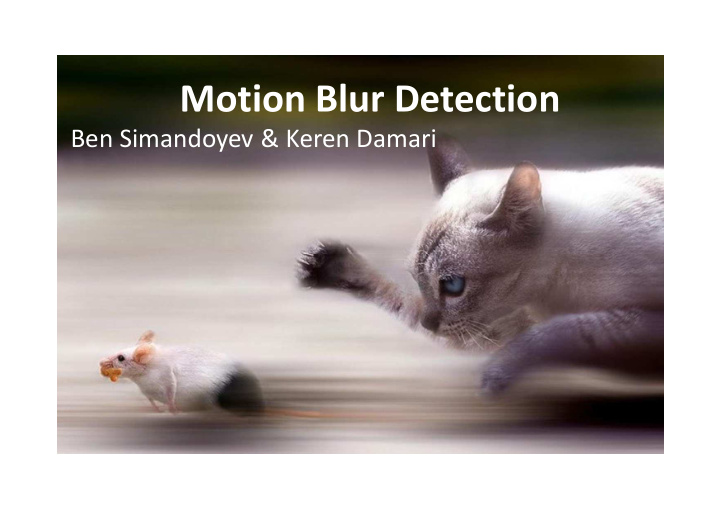



Motion Blur Detection Ben Simandoyev & Keren Damari
Blur in Images There are two main types of blur Out of Focus Motion Blur
Motion Blur Motion blur is usually created when the time of exposure is long relatively to the velocity of movement.
Motion Blur Typically, motion blur creates smoothness in the image on the direction of movement, and many edges in the vertical direction.
Previous Work Most of known methods of debluring require prior knowledge uses PSF which a kernel based on the angle and length of the motion. Original Picture Blurred, angle=30, Deblurred Picture lenth=50
Approach and Method 1. Edge Detection We used edge detection with high sensitivity. In a motion blurred image, we expected to find large amount of parallel lines in the direction of movement and very few lines in other directions.
Approach and Method 2. Divide to grids Since the blur could be local, we can expect part of the scene to be sharp. We divided the image matrix into grids, and looked for motion in each one of them
Approach and Method 3. Hough Transform The next step was to find parallel lines in the edge map, we used Hough transform for lines and serached for dominant direction.
Approach and Method 3. Hough Transform Teta=27 The angele comuted is 153
Results The result is a matrix represents the direction of blur detected in all parts, -1 if motion blur was not found. Here are the results as blue arrows.
Results Run time: 1.42586 sec Run time: 2.023569 sec
Results Run time: 3.25279 sec Run time: 1.71809 sec
Results Run time: 3.25279 sec Run time: 2.040075 sec
Results Run time: 1.44714 sec Run time: 1.75275 sec
Results Run time: 4.03007 sec Run time: 3.293323 sec
Results Better results can be achieved by different grid sizes, depending on the pictures size, the size of the object in motion and the motion direction change rate Division to 36 grids Division to 64 grids
Results Run time: 3.293323 sec
Conclusions Recognition of motion blurred images gives good results, recognition of about 80% in average of the the motion direction in the grids. Few pictures require lower threshold, more sensitive edge detector. The average run time for picture of size 1500X1000 is about 3.6 seconds. The majority of images with motion blur are recognized, but there is considerable amount of images without blur that are recognized as images with motion blur. Our suggestion is to run an algorithm to identify blurred areas prior to our algorithm, and try to detect motion only in those areas.
Conclusions When the algorithm successfully finds motions in a grid, the returned direction is a pretty good estimation of the real motion direction in that grid. Very dark or very bright areas of motion are more difficult to identify and requires lower threshold of edge detecting. In some pictures the edge detector find false edges at the ends, therefore motion recognition is more likely to fail in those areas and give false result. Future work: when the direction of movement is known, finding the amount of movement in that direction could help with restoration of images with motion blur.
Recommend
More recommend